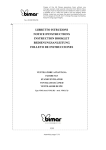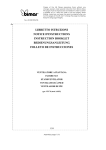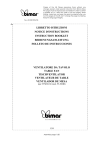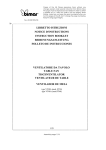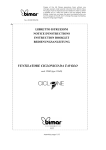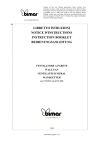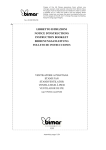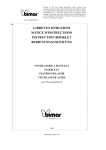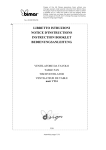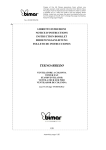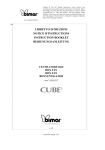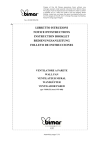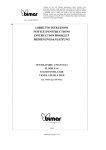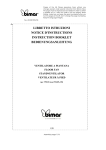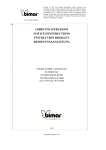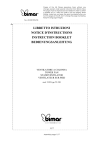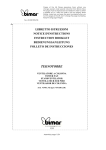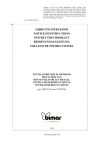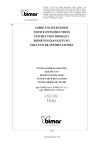Download Bimar VT34A
Transcript
Copies of the I/B. Please reproduce them without any changes except under special instruction from Bimar (Italy). The pages must be reproduced and folded in order to obtain a booklet A5 (+/- 148.5 mm width x 210 mm height). When folding, make sure you keep the good numbering when you turn the pages of the I/B. Don’t change the page numbering. Keep the language integrity. Fax +32 030 9904733 LIBRETTO ISTRUZIONI NOTICE D'INSTRUCTIONS INSTRUCTION BOOKLET BEDIENUNGSANLEITUNG FOLLETO DE INSTRUCCIONES VENTILATORE DA TAVOLO TABLE FAN TISCHVENTILATOR VENTILATEUR DE TABLE VENTILADOR DE MESA mod. VT24A (type VTx4)-mod.VT34A (type VTx4) mod.VT44A (type VTx4) 1/24 Assembly page 1/20 Copies of the I/B. Please reproduce them without any changes except under special instruction from Bimar (Italy). The pages must be reproduced and folded in order to obtain a booklet A5 (+/- 148.5 mm width x 210 mm height). When folding, make sure you keep the good numbering when you turn the pages of the I/B. Don’t change the page numbering. Keep the language integrity. Fax +32 030 9904733 Questo simbolo vi invita a leggere attentamente queste istruzioni prima dell’uso dell’apparecchio, ed eventualmente informare terzi, se necessario. CONSERVARE IL LIBRETTO PER ULTERIORI CONSULTAZIONI. Questo simbolo vi invita a prestare attenzione, ed a leggere gli specifici avvertimenti sul libretto istruzioni. Questo simbolo: indica che l’apparecchio è di classe II. AVVERTENZE GENERALI • Questo apparecchio è destinato solo all’impiego domestico, per la ventilazione di ambienti interni: non utilizzatelo per altro scopo. Ogni altro uso è da considerarsi improprio e pericoloso. Il costruttore non potrà essere ritenuto responsabile di eventuali danni derivanti da uso improprio, erroneo e irresponsabile e/o da riparazioni effettuate da personale non qualificato. • Alcuni modelli possono essere corredati con porta aromi per la profumazione d’ambienti, ideali per uffici, soggiorni, ecc…Per diffondere gli aromi, inumidire con alcune gocce di oli/essenze (non inclusi) il filtro, senza eccedere nella quantità in modo da non danneggiare le vernici del ventilatore, per effetto dell’olio/liquido ossidante. Agganciare il porta aromi alla griglia anteriore o posteriore (comunque all’esterno) tramite i gancetti ricavati posteriormente. • Non infilare alcun utensile o le dita fra le maglie della griglia di protezione della ventola. • Non utilizzare l’apparecchio con temperatura ambiente superiore a 40°C. • L’apparecchio può essere utilizzato da bambini di età non inferiore a 8 anni e da persone con ridotte capacità fisiche, sensoriali o mentali, o prive di esperienza o della necessaria conoscenza, purchè sotto sorveglianza oppure dopo che le stesse abbiano ricevuto istruzioni relative all’uso sicuro dell’apparecchio e alla comprensione dei pericoli ad esso inerenti. I bambini non devono giocare con l’apparecchio. La pulizia e la manutenzione destinata ad essere effettuata dall’utilizzatore non deve essere effettuata da bambini senza sorveglianza. • L’apparecchio deve essere mantenuto fuori dalla portata di bambini. • Attenzione: quando si utilizzano apparecchi elettrici, occorre sempre rispettare le precauzioni di sicurezza di base per evitare i rischi di incendio, di scosse elettriche e di lesioni fisiche. • Non usare l’apparecchio se non funziona correttamente o se sembra danneggiato; in caso di dubbio rivolgersi a personale professionalmente qualificato. • Assicurarsi che la ventola funzioni correttamente: nel caso contrario spegnere l’apparecchio e farlo controllare da personale professionalmente qualificato. • Non spostare l’apparecchio durante il funzionamento. • Scollegare sempre l’apparecchio dalla presa di corrente prima di assemblare, smontare e prima di pulire l’apparecchio. • Se l’apparecchio non è in funzione togliere la spina dalla presa di corrente. • Non lasciare l’apparecchio esposto agli agenti atmosferici (sole, pioggia, ecc.). • Non toccare l’apparecchio con mani o piedi bagnati. • Non tirare il cavo per spostare l’apparecchio. • Non tirare il cavo d’alimentazione o l’apparecchio stesso per disinserire la spina dalla presa di corrente. 2/24 Assembly page 2/20 Copies of the I/B. Please reproduce them without any changes except under special instruction from Bimar (Italy). The pages must be reproduced and folded in order to obtain a booklet A5 (+/- 148.5 mm width x 210 mm height). When folding, make sure you keep the good numbering when you turn the pages of the I/B. Don’t change the page numbering. Keep the language integrity. Fax +32 030 9904733 • Se il cavo di alimentazione è danneggiato, esso deve sostituito dal costruttore o dal suo servizio assistenza tecnica o comunque da una persona con qualifica similare, in modo da prevenire ogni rischio. INSTALLAZIONE • Dopo aver tolto l’imballaggio, assicurarsi dell’integrità dell’apparecchio; in caso di dubbio non utilizzarlo e rivolgersi a personale professionalmente qualificato. Gli elementi d’imballaggio (sacchetti di plastica, polistirolo espanso, chiodi, ecc.) non devono essere lasciati alla portata di mano di bambini in quanto potenziali fonti di pericolo, ma vanno smaltiti secondo le norme vigenti negli appositi contenitori per la raccolta differenziata. Attenzione: eventuali adesivi o fogli pubblicitari applicati sulla griglia, devono essere rimossi prima dell’uso dell’apparecchio. • Prima di collegare l’apparecchio controllare che i valori di tensione riportati sulla targa dati (220-240V~ 50Hz) corrispondano a quelli della rete elettrica. In caso di incompatibilità tra la presa e la spina dell’apparecchio, far sostituire la presa con altra di tipo adatto da personale professionalmente qualificato, il quale accerti che la sezione dei cavi della presa sia idonea alla potenza assorbita dall’apparecchio. In generale è sconsigliato l’uso di adattatori e/o prolunghe; se il loro uso si rendesse indispensabile, devono essere conformi alle vigenti norme di sicurezza e la loro portata di corrente (ampères) non deve essere inferiore a quella massima dell’apparecchio. • Prima di ogni utilizzo verificare che l’apparecchio sia in buono stato, che il cordone elettrico non sia danneggiato: in caso di dubbio rivolgersi a personale professionalmente qualificato. • La presa di corrente deve essere facilmente accessibile in modo da poter disinserire con facilità la spina in caso di emergenza. • Non posizionare l’apparecchio su mensole e/o in prossimità di lavandini o contenitori di liquidi (distanza minima 2 metri) per evitare il rischio che vi possa cadere. • Posizionare il ventilatore lontano da tessuti (tende, ecc.) o materiali volatili che possano ostruire la griglia di aspirazione; verificare che anche la parte anteriore sia sgombra da materiali volatili ( polvere, ecc.). • Posizionare l’apparecchio lontano da fonti di calore (ad es. fiamme libere, fornello gas, ecc). • Non posizionare il ventilatore su mensole e su davanzali di finestre. • La superficie di appoggio deve essere stabile, non in pendenza (in quanto l’apparecchio potrebbe ribaltarsi) e liscia. • Questo apparecchio non è destinato a essere fatto funzionare per mezzo di un temporizzatore esterno o con un sistema di comando a distanza separato, per evitare il rischio di incendio nel caso l’apparecchio sia coperto o sia posizionato in modo non corretto. • Non allacciare l’apparecchio a sistemi di controllo termico o programmatore o timer o ad altro dispositivo che possa accendere l’apparecchio automaticamente, evitando così rischi di danni a persone, animali o cose. • In caso di guasto o cattivo funzionamento spegnere l’apparecchio e farlo controllare da personale professionalmente qualificato; le riparazioni effettuate da personale non qualificato possono essere pericolose e fanno decadere la garanzia. ASSEMBLAGGIO (mod. VT34A-VT44A) Attenzione: il ventilatore può essere utilizzato solo se completamente e correttamente assemblato, cioè completo di base e di griglia di protezione. Nel caso di dubbio far controllare o eseguire l’operazione da personale professionalmente qualificato. Per l’assemblaggio si prenda come riferimento la fig.1. 3/24 Assembly page 3/20 Copies of the I/B. Please reproduce them without any changes except under special instruction from Bimar (Italy). The pages must be reproduced and folded in order to obtain a booklet A5 (+/- 148.5 mm width x 210 mm height). When folding, make sure you keep the good numbering when you turn the pages of the I/B. Don’t change the page numbering. Keep the language integrity. Fax +32 030 9904733 Attenzione: prima di assemblare il ventilatore, assicurarsi che sia scollegato dalla presa di corrente. 1) Inserire il cordone (9) attraverso il foro della base e innestare la base al lembo inferiore della colonna facendo attenzione alla corretta posizione dell’una rispetto all’altra. Fissare le parti tramite le “3” viti in dotazione, bloccandole in modo normale. 2) Fissare il cordone alla base mediante la piastrina in plastica. 3) Inserire la maniglia (12) nel carter motore, in modo che i 4 perni si inseriscano nelle asole corrispondenti. La maniglia deve essere orientata nel modo corretto (verso l’alto e la parte posteriore), altrimenti non si può fissare la griglia. 4) Fissare la griglia posteriore (6) al carter motore, posizionarla in modo che perni e fori siano corrispondenti, e bloccarla con l’apposita ghiera (5). 5) Inserire la ventola (3) sull’albero motore e bloccare con l’apposita ghiera (2) avvitandola in senso antiorario e in modo serrato. 6) Accoppiare la griglia anteriore (1) a quella posteriore (6) bloccandole con anello in plastica (4), assicurando il fissaggio con l’apposita vite c/dado, (la vite deve risultare nella parte inferiore). Al termine dell’operato, verificare che le griglia di protezione siano saldamente accoppiate e fissate al motore. Mod.VT34A-VT44A Fig.1 1) Griglia anteriore/schermo di protezione 2) Ghiera fissaggio ventola 3) Ventola 4) Anello in plastica 5) Ghiera fissaggio griglia 6) Griglia posteriore 7) Pulsante oscillazione 8) Selettore 9) Cordone 10) Base 11) Viti fissaggio base 12) Maniglia ASSEMBLAGGIO (mod. VT24A) Attenzione: il ventilatore può essere utilizzato solo se completamente e correttamente assemblato, cioè completo di base e di griglia di protezione. Nel caso di dubbio far controllare o eseguire l’operazione da personale professionalmente qualificato. Per l’assemblaggio si prenda come riferimento la fig.1. Attenzione: prima di assemblare il ventilatore, assicurarsi che sia scollegato dalla presa di corrente. 1) Inserire il cordone (20) attraverso il foro della base e innestare la base al lembo inferiore della colonna facendo attenzione alla corretta posizione dell’una rispetto all’altra. Fissare le parti tramite le “3” viti in dotazione, bloccandole in modo normale. 2) Fissare il cordone alla base mediante la piastrina in plastica. 4/24 Assembly page 4/20 Copies of the I/B. Please reproduce them without any changes except under special instruction from Bimar (Italy). The pages must be reproduced and folded in order to obtain a booklet A5 (+/- 148.5 mm width x 210 mm height). When folding, make sure you keep the good numbering when you turn the pages of the I/B. Don’t change the page numbering. Keep the language integrity. Fax +32 030 9904733 3) Inserire la maniglia (23) nel carter motore, in modo che i 4 perni si inseriscano nelle asole corrispondenti. La maniglia deve essere orientata nel modo corretto (verso l’alto e la parte posteriore), altrimenti non si può fissare la griglia. 4) Fissare la griglia posteriore (17) al carter motore, posizionarla in modo che perni e fori siano corrispondenti, e bloccarla con l’apposita ghiera (16). 5) Inserire a fondo la ventola (14) sull’albero motore. 6) Accoppiare la griglia anteriore (13) a quella posteriore (17) bloccandole con anello in plastica (15), assicurando il fissaggio con l’apposita vite c/dado, (la vite deve risultare nella parte inferiore). Al termine dell’operato, verificare che le griglia di protezione siano saldamente accoppiate e fissate al motore. mod.VT24A Fig.1 13) Griglia anteriore/schermo di protezione 14) Ventola 15) Anello in plastica 16) Ghiera fissaggio griglia 17) Griglia posteriore 18) Pulsante oscillazione 19) Selettore 20) Cordone 21) Base 22) Viti fissaggio base 23) Maniglia USO Prima di ogni utilizzo verificare che l’apparecchio sia in buono stato, che il cordone elettrico non sia danneggiato: se il cavo di alimentazione è danneggiato, esso deve sostituito dal costruttore o dal suo servizio assistenza tecnica o comunque da una persona con qualifica similare, in modo da prevenire ogni rischio. Inserire la spina nella presa di corrente. Ventilazione: selezionare la velocità desiderata ruotando l’interruttore in corrispondenza delle seguenti posizioni: 1–Velocità minima 2–Velocità media 3–Velocità massima Per spegnere ruotare l’interruttore in posizione “0” e successivamente togliere la spina dalla presa di corrente. Oscillazione orizzontale (destra-sinistra): si ottiene premendo l’apposito pulsante situato sul corpo motore. Per eliminare il movimento e mantenere fermo il ventilatore, sollevare il pulsante. Inclinazione verticale (alto-basso): si regola impugnando il corpo motore e dirigendolo nella direzione desiderata; udirete dei “click” che identificano le diverse posizioni che possono essere assunte dal ventilatore. Per lunghi periodi di inattività, togliere la spina dalla presa di corrente. 5/24 Assembly page 5/20 Copies of the I/B. Please reproduce them without any changes except under special instruction from Bimar (Italy). The pages must be reproduced and folded in order to obtain a booklet A5 (+/- 148.5 mm width x 210 mm height). When folding, make sure you keep the good numbering when you turn the pages of the I/B. Don’t change the page numbering. Keep the language integrity. Fax +32 030 9904733 PULIZIA E MANUTENZIONE Attenzione: prima di eseguire le normali operazioni di pulizia, togliere la spina dalla presa di corrente. • Assicurarsi che il ventilatore sia scollegato dalla rete di alimentazione prima di togliere lo schermo di protezione (12). • Per la pulizia utilizzare un panno morbido, leggermente inumidito; non utilizzare prodotti abrasivi o corrosivi. • Non immergere nessuna parte del ventilatore in acqua o altro liquido: nel caso dovesse succedere non immergere la mano nel liquido ma per prima cosa togliere la spina dalla presa di corrente. Asciugare con cura l’apparecchio e verificare che tutte le parti elettriche siano asciutte: in caso di dubbio rivolgersi a personale professionalmente qualificato. • E’ indispensabile mantenere i fori di aerazione del motore liberi da polvere e lanugine. • Controllare periodicamente che il cordone elettrico non sia danneggiato, per la sua sostituzione necessita un utensile speciale: rivolgersi ad un centro assistenza autorizzato anche per eventuali riparazioni. • Per periodi lunghi di inutilizzo, è necessario stivare il ventilatore al riparo da polvere e umidità; consigliamo di utilizzare l’imballo originale. • Se si decide di non utilizzare più l’apparecchio, si raccomanda di renderlo inoperante tagliando il cavo di alimentazione (prima assicurarsi d’aver tolto la spina dalla presa di corrente), e di rendere innocue quelle parti che sono pericolose qualora utilizzate per gioco dai bambini (ad esempio l’elica). • Non disperdere nell’ambiente prodotti non biodegradabili, ma smaltirli nel rispetto delle norme vigenti. Alla fine della sua vita utile il prodotto non deve essere smaltito insieme ai rifiuti urbani. Può essere consegnato presso gli appositi centri di raccolta differenziata predisposti dalle amministrazioni comunali, oppure presso i rivenditori che forniranno questo servizio all’acquisto di un nuovo apparecchio. Smaltire separatamente un elettrodomestico consente di evitare possibili conseguenze negative per l’ambiente e per la salute derivanti da un suo smaltimento inadeguato e permette di recuperare i materiali di cui è composto al fine di ottenere un importante risparmio di energia e risorse. Per rimarcare l’obbligo di smaltire separatamente gli elettrodomestici, sul prodotto è riportato il marchio del contenitore di spazzatura mobile barrato. 6/24 Assembly page 6/20 Copies of the I/B. Please reproduce them without any changes except under special instruction from Bimar (Italy). The pages must be reproduced and folded in order to obtain a booklet A5 (+/- 148.5 mm width x 210 mm height). When folding, make sure you keep the good numbering when you turn the pages of the I/B. Don’t change the page numbering. Keep the language integrity. Fax +32 030 9904733 Please read these instructions carefully before using the appliance, and instruct other persons using it, too, when necessary. Keep booklet handy for further use. This symbol show: the appliance is class II equiment. GENERAL NOTICES • This device is intended for home use only, to ventilate rooms, and in the manner described in this manual: do not use it for any other purpose. Any other use is to be considered inappropriate and therefore dangerous. The manufacturer cannot be held responsible for eventual damage caused by inappropriate, improper or irresponsible use and/or for repairs made to the product by unauthorised personnel. • Some models can be provided with perfume diffusers to refresh the environment, ideal for offices, sitting rooms, etc…To diffuse the aromas, moisten the filter with a few drops of oil/essence (not included). Do not exaggerate the quantity because the oxidising effect of the oil could damage the paint on the fan. Attach the diffuser to the front or back grid (always outside) by means of the hooks on the back. • Do not touch the appliance with wet hands or feet. • Do not insert any tool, or your fingers, into the grille protecting the blades. • This appliance can be used by children aged from 8 years and above and persons with reduced physical, sensory or mental capabilities or lack of experience and knowledge if they have been given supervision or instruction concerning use of the appliance in a safe way and if they understand the hazards involved. Children shall not play with the appliance. Cleaning and user maintenance shall not be made by children without supervision. • The appliance must be kept out of children’s reach. • Attention: when using electric appliances, the basic safety precautions must always be observed to avoid risks of fire, electric shocks and physical injury. • Do not use the appliance if it is not operating correctly or seems damaged; if in doubt, contact professionally qualified personnel. • Make sure that the appliance is working correctly: if not, turn the appliance off and have it checked by professionally qualified personnel. • Do not move the appliance when it is operating. • Unplug the appliance when not in use. • Do not use the device at room temperatures above 40 °C. • Do not move the appliance when it is in function. • Do not leave the device exposed to the weather (sun, rain, etc.). • Do not pull on the cord to disconnect the plug from the socket. • Do not allow children, or irresponsible persons, to use the device without supervision. • If the electric cord is damaged, it has to be replaced by the supplier or an authorized service center or a professionally qualified, to avoid any risks. INSTALLATION • After removing the packing materials, check the integrity of the heater; if you are unsure, do not use it and ask for qualified professional help. The packing materials (plastic bags, polystyrene foam, nails, etc.) must be kept out the reach of children because they are potential sources of danger. Attention: any stickers or advertising material applied to the grid removed before using the appliance. The manufacturer declines all responsibility in case this is not safe working practices will be respected. 7/24 Assembly page 7/20 Copies of the I/B. Please reproduce them without any changes except under special instruction from Bimar (Italy). The pages must be reproduced and folded in order to obtain a booklet A5 (+/- 148.5 mm width x 210 mm height). When folding, make sure you keep the good numbering when you turn the pages of the I/B. Don’t change the page numbering. Keep the language integrity. Fax +32 030 9904733 • Before connecting the appliance, check that the voltage values shown on the data plate (220240V~ 50Hz) correspond to those of the electricity supply network. In the event of incompatibility between the electric outlet and the plug of the appliance, have the outlet replaced with another more suitable type by professionally qualified personnel, who will make sure that the section of the wires of the outlet is appropriate for the absorbed power of the heater. In general, the use of adapters or extension cords is not recommended; if their use is indispensable, they must conform to existing safety standards and their current capacity (amperes) must not be less that the maximum of the heater. • The power socket must be easy to reach so the plug can be removed quickly in case of emergency. • Do not place the fan on a shelf and/or near sinks or other container of liquids (minimum distance of 2 meters) to avoid the risk of it falling in. • Keep the fan far away from fabrics (curtains, etc.) or unstable materials that could obstruct the air intake grille; make sure that the front is free of unstable materials (dust, etc.). • Make sure that the electric cord is not touching rough, hot or moving surfaces and not twisted or wrapped around the appliance. • Stand the appliance on a horizontal, flat surface or table; do not stand on a inclined plane (the appliance could upset). • Do not place the appliance near an open flame, cooking or other heating appliance. • Do not use the appliance with a timer or a programmer or with a system that can switch on the appliance automatically, to avoid risk of fire, since a fire risk exists if the heater is covered or positioned incorrectly. • In the event of a breakdown or poor operation, turn the fan heater off and ask for professionally qualified help. ASSEMBLY (mod. VT34A-VT44A) Attention: the fan can be used only when completely and correctly assembled, that is complete with its base and protection grid. If in doubt, have the appliance checked or assembled by a qualified professional person. For assembly, refer to figure. Attention: always unplug the appliance before you assemble 1) Pass the cable (9) through the hole in the base and engage the base on the bottom part of the column, making sure they are correctly positioned one against the other. Fasten the parts using the screws provided “3” and lock them in a normal way. 2) Fasten the cable to the base using the plastic plate. 3) Insert the handle (12) in the motor casing so the 4 pins enter the corresponding slots. The handle must be positioned correctly (upwards and towards the back part), otherwise the grid cannot be fastened. 4) Fasten the rear grid (6) to the motor casing, positioning the corresponding pins and holes, and lock using the appropriate ring nut (5). 5) Insert the fan (3) on the motor shaft and lock with the appropriate ring nut (2) turning it tightly anti-clockwise. 6) Couple the front grid (1) with the rear grid (6) and lock with the plastic ring (4) and ensure the fastening with the appropriate locking screw, (the screw must be in the lower part). Having done this, check that the protection grid is firmly coupled and fastened to the motor. 8/24 Assembly page 8/20 Copies of the I/B. Please reproduce them without any changes except under special instruction from Bimar (Italy). The pages must be reproduced and folded in order to obtain a booklet A5 (+/- 148.5 mm width x 210 mm height). When folding, make sure you keep the good numbering when you turn the pages of the I/B. Don’t change the page numbering. Keep the language integrity. Fax +32 030 9904733 Mod.VT34A-VT44A 1. 2. 3. 4. 5. 6. 7. 8. 9. 10. 11. 12. Pic.1 Front grille Fan attachment ring nut Fan Grille attachment ring nut Screw for the plastic ring Rear grille Oscillation button Selector Cord Base Screw of the base Handle ASSEMBLY (mod. VT24A) Attention: the fan can be used only when completely and correctly assembled, that is complete with its base and protection grid. If in doubt, have the appliance checked or assembled by a qualified professional person. For assembly, refer to figure. Attention: always unplug the appliance before you assemble 1) Pass the cable (20) through the hole in the base and engage the base on the bottom part of the column, making sure they are correctly positioned one against the other. Fasten the parts using the screws provided “3” and lock them in a normal way. 2) Fasten the cable to the base using the plastic plate. 3) Insert the handle (23) in the motor casing so the 4 pins enter the corresponding slots. The handle must be positioned correctly (upwards and towards the back part), otherwise the grid cannot be fastened. 4) Fasten the rear grid (17) to the motor casing, positioning the corresponding pins and holes, and lock using the appropriate ring nut (16). 5) Insert the fan (14) on the motor shaft. 6) Couple the front grid (13) with the rear grid (17) and lock with the plastic ring and ensure the fastening with the appropriate locking screw (15), (the screw must be in the lower part). Having done this, check that the protection grid is firmly coupled and fastened to the motor. 9/24 Assembly page 9/20 Copies of the I/B. Please reproduce them without any changes except under special instruction from Bimar (Italy). The pages must be reproduced and folded in order to obtain a booklet A5 (+/- 148.5 mm width x 210 mm height). When folding, make sure you keep the good numbering when you turn the pages of the I/B. Don’t change the page numbering. Keep the language integrity. Fax +32 030 9904733 Mod.VT24A 13. Front grille 14. Fan 15. Grille attachment ring nut 16. Screw for the plastic ring 17. Rear grille 18. Oscillation button 19. Selector 20. Cord 21. Base 22. Screw of the base 23. Handle Pic.1 USE Insert the plug of the fan in the power supply. Ventilation: select the desired speed by turning the switch to one of the following positions: 1– Minimum speed 2–Medium speed 3–Maximum speed To turn off, turn the switch to position 0 and then remove the plug from the socket. Horizontal oscillation (right-left): this is selected with the button located on the motor body. To stop the motion and keep the ventilator still, press the button. Vertical inclination (high-low): it is regulated by gripping the motor body and orienting it in the direction desired; you will hear “clicks” that indicate the fan's various positions. When not in use for long periods, the plug must always be removed from the socket. CLEANING AND MAINTENANCE Attention: before normal cleaning, remove the plug from the socket. • Ensure that the fan is switched off from the supply mains before removing the guard. • Clean the body with soft, slightly damp, cloth; do not use abrasive or corrosive products. • Do not immerse any part of the fan in water or other liquid: if this should happen, do not put your hand in the liquid, but first remove the plug from the socket. Carefully dry the appliance and make sure that all the electrical parts are dry: in the case of doubt, ask for professionally qualified help. • It is essential that the motor's air holes be kept from dust and lint. • Periodically check the electric cord for damage; its replacement requires a special tool: contact an authorized service center, also for any repairs. • If the fan will not be used for long periods, it must be protected from dust and humidity; we recommend storing it in its original packaging. • Should you decide not to use the appliance any more, we recommend making it inoperative by cutting the power cord (after making sure you have disconnected the plug from the socket) and make dangerous parts harmless if children are allowed to play with them (such as the blade). • Do not dispose of non-biodegradable products in the environment but dispose of them in accordance with current law. At the end of its working life, the product must not be disposed of as urban waste. It must be taken to a special local authority differentiated waste collection centre or to a dealer providing this service. Disposing of a household appliance separately avoids possible negative consequences for the environment and health deriving from inappropriate disposal and enables the constituent materials to be recovered to obtain significant savings in energy and resources. 10/24 Assembly page 10/20 Copies of the I/B. Please reproduce them without any changes except under special instruction from Bimar (Italy). The pages must be reproduced and folded in order to obtain a booklet A5 (+/- 148.5 mm width x 210 mm height). When folding, make sure you keep the good numbering when you turn the pages of the I/B. Don’t change the page numbering. Keep the language integrity. Fax +32 030 9904733 Bitte lesen Sie vor der Benutzung des Gerätes sorgfältig diese Anleitungen und setzen Sie gegebenenfalls Dritte darüber in Kenntnis. Gebrauchsanleitung zum weitren Nachschlagen aufbewahren. Dieses Symbol zeigt an, dass es sich um ein Gerät der Klasse II handelt. ALLGEMEINE HINWEISE • Dieses Gerät ist ausschließlich für den Gebrauch im Haushalt zum Belüften von Räumen bestimmt: Verwenden Sie es zu keinem anderen Zweck. Jede andere Anwendung wird als unsachgemäß und deshalb gefährlich betrachtet. Der Hersteller übernimmt keine Haftung für eventuelle Schäden infolge von unsachgemäßer, falscher oder unverantwortlicher Verwendung und/oder Reparaturen, die nicht von Fachpersonal durchgeführt wurden. • Einige Modelle sind mit einem Dufthalter ausgestattet, um für frischen Raumduft zu sorgen; ideal für Büros, Wohnzimmer usw. Zum Verbreiten von Aromen den Filter mit einigen Tropfen Öl/Essenz (nicht mitgeliefert) befeuchten. Übertreiben Sie es dabei nicht mit der Menge, um den Lack des Ventilators durch die Oxidationswirkung des Öls/der Flüssigkeit nicht zu beschädigen. Den Dufthalter an das vordere oder hintere Gitter hängen (grundsätzlich an der Außenseite) und dazu die speziellen Haken benutzen. • Keinesfalls Werkzeuge oder Finger durch das Schutzgitter des Flügelrads einführen. • Verwenden Sie das Gerät nicht bei Umgebungstemperaturen von über 40 °C. • Kinder unter 8 Jahren, Personen mit eingeschränkten körperlichen, sensorischen oder geistigen Fähigkeiten sowie Personen ohne entsprechende Erfahrung oder Kenntnisse dürfen dieses Gerät nur unter Aufsicht oder nach Erhalt aller Anweisungen für die sichere Verwendung des Gerätes sowie Auskunft über die damit verbundenen Gefahren benutzen. Kinder sollten beaufsichtigt werden, um sicherzustellen, dass sie nicht mit dem Gerät spielen. Vom Anwender durchzuführende Reinigungsund Wartungsarbeiten dürfen nicht von Kindern ohne Aufsicht durchgeführt werden. • Bewahren Sie das Gerät außerhalb der Reichweite von Kindern auf. • Achtung: Beim Umgang mit Elektrogeräten immer die grundsätzlichen Sicherheitsmaßnahmen beachten. Damit vermeiden Sie Brandgefahr sowie die Gefahr von Stromschlägen und Körperverletzungen. • Benutzen Sie das Gerät nicht, wenn es nicht einwandfrei funktioniert oder beschädigt zu sein scheint. Im Zweifelsfall wenden Sie sich an eine Fachkraft. • Vergewissern Sie sich, dass das Flügelrad korrekt funktioniert: Sollte dem nicht so sein, schalten Sie das Gerät ab, und lassen Sie es durch entsprechend qualifiziertes Fachpersonal überprüfen. • Verrücken Sie das Gerät nicht während des Betriebs. • Trennen Sie das Gerät immer erst von der Steckdose, bevor Sie es auseinander- oder zusammenbauen oder reinigen. • Wenn das Gerät nicht in Betrieb ist, ziehen Sie den Stecker aus der Steckdose. • Setzen Sie das Gerät nicht der Witterung (direkte Sonneneinstrahlung, Regen usw.) aus. • Berühren Sie das Gerät niemals mit nassen oder feuchten Händen oder Füßen. • Ziehen Sie nie am Netzkabel, um das Gerät zu verrücken. • Ziehen Sie nicht am Kabel, um den Netzstecker aus der Steckdose zu ziehen. • Eins beschädigtes Netzkabel muss vom Hersteller, seinem Kundendienst oder von einem entsprechend qualifizierten Fachmann ausgewechselt werden, damit jegliche Risiken ausgeschlossen werden können. 11/24 Assembly page 11/20 Copies of the I/B. Please reproduce them without any changes except under special instruction from Bimar (Italy). The pages must be reproduced and folded in order to obtain a booklet A5 (+/- 148.5 mm width x 210 mm height). When folding, make sure you keep the good numbering when you turn the pages of the I/B. Don’t change the page numbering. Keep the language integrity. Fax +32 030 9904733 INSTALLATION • Prüfen Sie nach dem Auspacken, dass das Gerät unversehrt ist; benutzen Sie das Gerät im Zweifelsfall auf keinen Fall und wenden Sie sich an entsprechend qualifiziertes Fachpersonal. Das Verpackungsmaterial (Kunststoffbeutel, Polystyrolschaum usw.) darf nicht in die Reichweite von Kindern gelangen, da es eine Gefahrenquelle darstellt, und es und muss gemäß den geltenden Bestimmungen in den entsprechenden Behältern für die getrennte Abfallentsorgung entsorgt werden. Achtung: Eventuelle Aufkleber oder Werbezettel am Gitter müssen vor dem Gebrauch des Gerätes von diesem entfernt werden. • Bevor Sie das Gerät an die Steckdose anschließen, kontrollieren Sie, dass die auf dem Typenschild angegebenen Werte mit denen der Stromversorgung übereinstimmen (220-240V~ 50Hz). Sollten der Stecker des Gerätes und die vorhandene Steckdose nicht kompatibel sein, lassen Sie die Steckdose von entsprechend qualifiziertem Fachpersonal austauschen. Dieses muss sicherstellen, dass der Querschnitt der Kabel der Steckdose für die Leistungsaufnahme des Gerätes geeignet ist. Im Allgemeinen wird von der Verwendung von Verlängerungen und/oder Adaptern abgeraten. Falls ihre Verwendung jedoch unumgänglich ist, so müssen diese den geltenden Sicherheitsvorschriften entsprechen und ihre Stromstärke (Ampere) darf nicht niedriger sein, als die maximale Stromstärke des Gerätes. • Prüfen Sie vor jeder Verwendung, dass sich das Gerät in einem guten Zustand befindet und dass das Stromkabel nicht beschädigt ist: Wenden Sie sich im Zweifelsfall an entsprechend qualifiziertes Personal. • Die Steckdose muss leicht zugänglich sein, damit der Stecker im Bedarfsfall problemlos aus der Steckdose gezogen werden kann. • Stellen Sie das Gerät nicht auf Konsolen und/oder in der Nähe von Waschbecken oder Flüssigkeitsbehältern auf (Mindestabstand 2 Meter), damit es nicht hineinfallen kann. • Stellen Sie den Ventilator nicht in der Nähe von Stoffen (Vorhänge usw.) oder fliegenden Materialien auf, die das Schutzgitter auf der Saugseite verdecken könnten; vergewissern Sie sich auch, dass der vordere Teil sauber und unverstellt ist ist (ohne Staub usw.). • Stellen Sie das Gerät nicht in der Nähe von Hitzequellen auf (z. B. offene Flammen, Gasofen etc.). • Stellen Sie den Ventilator nicht auf Konsolen oder Fensterstöcke. • Stellen Sie das Gerät auf einer stabilen, waagerechten und glatten Fläche auf (das Gerät könnte sonst umkippen). • Benutzen Sie das Gerät nicht mit einer Zeitschaltuhr oder einem sonstigen System zur Programmierung oder Fernbedienung, um Brandgefahr zu vermeiden, falls das Gerät abgedeckt oder nicht ordnungsgemäß positioniert ist. • Schließen Sie das System nicht an thermische Steuersysteme, Programmiergeräte, Timer oder andere Geräte oder Systeme an, die das Gerät automatisch starten können, um Verletzungen und Schäden an Personen, Tieren und Sachen zu verhindern. • Schalten Sie das Gerät bei einem Defekt oder einer Störung sofort ab und lassen Sie es von einer Fachkraft kontrollieren; Reparaturen durch unqualifiziertes Personal können gefährlich sein und führen zum Verfall der Garantie. MONTAGE (mod. VT34A-VT44A) Achtung: der Ventilator kann ausschließlich bei vollständiger und ordnungsgemäßer Montage verwendet werden, d.h. mit Grundgestell, Halterung und Schutzgitter. Im Zweifelsfall lassen Sie bitte diese Arbeit von qualifizierten Fachkräften kontrollieren oder durchführen. Für die Montage verweisen wir auf Abb. 1. 1) Kabel (9) in das Loch des Grundgestells einführen und das Grundgestell in die untere Säulenkante einrasten. Achten Sie dabei auf die ordnungsgemäße gegenseitige Position. Die Teile durch die “3” mitgelieferten Schrauben verbinden und sie normal feststellen. 2) Kabel mit Kunststoffplatte am Grundgestell befestigen. 12/24 Assembly page 12/20 Copies of the I/B. Please reproduce them without any changes except under special instruction from Bimar (Italy). The pages must be reproduced and folded in order to obtain a booklet A5 (+/- 148.5 mm width x 210 mm height). When folding, make sure you keep the good numbering when you turn the pages of the I/B. Don’t change the page numbering. Keep the language integrity. Fax +32 030 9904733 3) Den Griff (12) in das Motorgehäuse einstecken, die 4 Stifte müssen dabei in die entsprechenden Löcher eingesteckt werden. Der Griff muss ordnungsgemäß ausgerichtet sein (nach oben und nach hinten), andernfalls kann das Gitter nicht befestigt werden. 4) Das Rückgitter (6) am Motorgehäuse befestigen, dabei so positionieren, dass Stifte und Löcher fluchten und durch die entsprechende Nutmutter (5) feststellen. 5) Das Gebläse (3) auf die Motorwelle stecken und durch die entsprechende Nutmutter (2) feststellen, dabei gegen den Uhrzeigersinn festschrauben. 6) Vordergitter (1) und Rückgitter (6) miteinander verbinden und mit dem Kunststoffring feststellen. Die Befestigung mit der entsprechenden Schraube /Gegenmutter (4) sichern (die Schraube muss sich im unteren Teil befinden). Am Ende des Vorgangs stellen Sie bitte sicher, dass die Schutzgitter fest miteinander verbunden und am Motor befestigt sind. Mod.VT34A-VT44A Fig.1 1. 2. 3. 4. 5. 6. 7. 8. 9. 10. 11. 12. Vorderes Schutzgitter Arretierring des Flügelrads Flügelrad Kunststoffring-Schraube Arretierring des Standrohrs Hinteres Schutzgitter Taste für Schwenkbewegung Wahlschalter Netzstecker Fuß Schraube Hinterer Transportgriff MONTAGE (mod. VT24A) Achtung: der Ventilator kann ausschließlich bei vollständiger und ordnungsgemäßer Montage verwendet werden, d.h. mit Grundgestell, Halterung und Schutzgitter. Im Zweifelsfall lassen Sie bitte diese Arbeit von qualifizierten Fachkräften kontrollieren oder durchführen. Für die Montage verweisen wir auf Abb. 1. 1) Kabel (20) in das Loch des Grundgestells einführen und das Grundgestell in die untere Säulenkante einrasten. Achten Sie dabei auf die ordnungsgemäße gegenseitige Position. Die Teile durch die “3” mitgelieferten Schrauben verbinden und sie normal feststellen. 2) Kabel mit Kunststoffplatte am Grundgestell befestigen. 3) Den Griff (23) in das Motorgehäuse einstecken, die 4 Stifte müssen dabei in die entsprechenden Löcher eingesteckt werden. Der Griff muss ordnungsgemäß ausgerichtet sein (nach oben und nach hinten), andernfalls kann das Gitter nicht befestigt werden. 4) Das Rückgitter (17) am Motorgehäuse befestigen, dabei so positionieren, dass Stifte und Löcher fluchten und durch die entsprechende Nutmutter (16) feststellen. 5) Das Gebläse (14) auf die Motorwelle. 6) Vordergitter (1) und Rückgitter (13) miteinander verbinden (17) und mit dem Kunststoffring feststellen. Die Befestigung mit der entsprechenden Schraube /Gegenmutter (15) sichern (die Schraube muss sich im unteren Teil befinden). Am Ende des Vorgangs stellen Sie bitte sicher, dass die Schutzgitter fest miteinander verbunden und am Motor befestigt sind. 13/24 Assembly page 13/20 Copies of the I/B. Please reproduce them without any changes except under special instruction from Bimar (Italy). The pages must be reproduced and folded in order to obtain a booklet A5 (+/- 148.5 mm width x 210 mm height). When folding, make sure you keep the good numbering when you turn the pages of the I/B. Don’t change the page numbering. Keep the language integrity. Fax +32 030 9904733 Mod.VT24A 13. 14. 15. 16. 17. 18. 19. 20. 21. 22. 23. Vorderes Schutzgitter Flügelrad Kunststoffring-Schraube Arretierring des Standrohrs Hinteres Schutzgitter Taste für Schwenkbewegung Wahlschalter Netzstecker Fuß Schraube Hinterer Transportgriff GEBRAUCH Stecken Sie den Netzstecker in die Netzsteckdose. Lüftung: zur Auswahl der gewünschten Drehzahl den Schalter auf eine der folgenden Stellungen drehen: 1–Langsamste Geschwindigkeit 2–Mittlere Geschwindigkeit 3 – Maximale Geschwindigkeit Zum Abschalten den Schalter auf die Position “0” drehen und anschließend das Netzkabel ziehen. Waagrechte Schwenkbewegung (rechts-links): Zum Aktivieren der Schwenkbewegung müssen Sie die Taste auf dem Motorgehäuse drücken. Wenn Sie die Bewegung stoppen wollen, damit der Ventilator in einer festen Position verbleibt, müssen Sie die Taste herausziehen. Senkrechte Neigung (oben-unten): Neigen Sie das Motorgehäuse mit den Händen in die gewünschte Richtung. Die Raststellungen des Ventilators erkennen Sie am "Klicken". Bei längerem Gerätestillstand den Stecker aus der Steckdose ziehen REINIGUNG UND PFLEGE Achtung: ziehen Sie den Netzstecker aus der Netzsteckdose, bevor Sie das Gerät reinigen. • Verwenden Sie zum Reinigen ein weiches, leicht feuchtes Tuch. Verwenden Sie keine scheuernden oder aggressiven Reinigungsmittel. • Kein Teil des Ventilators darf in Wasser oder andere Flüssigkeiten eingetaucht werden: Sollte dies geschehen, keinesfalls die Hand in die Flüssigkeit tauchen, sondern als Erstes den Netzstecker aus der Netzsteckdose ziehen. Trocknen Sie das Gerät sorgfältig und vergewissern Sie sich, dass alle elektrischen Teile trocken sind: Wenden Sie sich im Zweifelsfall an einen Fachmann. • Die Lüftungsöffnungen des Motors müssen unbedingt frei von Staub und sonstigen Verunreinigungen gehalten werden. • Vergewissern Sie sich regelmäßig, dass das Netzkabel intakt ist. Für den Austausch benötigt man ein Spezialwerkzeug: Wenden Sie sich - auch für eventuelle Reparaturen - an ein Kundendienstzentrum. • Wenn Sie den Ventilator längere Zeit nicht verwenden wollen, müssen Sie ihn geschützt vor Staub und Feuchtigkeit aufbewahren. Wir empfehlen Ihnen, hierzu die Originalverpackung zu verwenden. • Wenn Sie vorhaben, das Gerät nicht mehr zu verwenden, sollten Sie es unbrauchbar machen, indem Sie das Netzkabel abschneiden. Vergewissern Sie sich vorher, dass Sie den Netzstecker aus der Netzsteckdose gezogen haben! Außerdem sollten Sie dafür Sorge tragen, dass die gefährlichen Teile (wie z.B. das Flügelrad) keine Verletzungen verursachen können, wenn Sie von Kindern zum Spielen verwendet werden. 14/24 Assembly page 14/20 Copies of the I/B. Please reproduce them without any changes except under special instruction from Bimar (Italy). The pages must be reproduced and folded in order to obtain a booklet A5 (+/- 148.5 mm width x 210 mm height). When folding, make sure you keep the good numbering when you turn the pages of the I/B. Don’t change the page numbering. Keep the language integrity. Fax +32 030 9904733 • Belasten Sie die Umwelt nicht mit Produkten, die biologisch nicht abbaubar sind, sondern entsorgen Sie dieselben im Einklang mit den geltenden Vorschriften. Am Ende seiner Nutzzeit darf das Produkt nicht zusammen mit dem Stadtmüll beseitigt werden. Es kann zu den eigens von den städtischen Behörden eingerichteten Sammelstellen oder zu den Fachhändlern, die einen Rücknahmeservice anbieten, gebracht werden. Die getrennte Entsorgung eines Haushaltsgerätes vermeidet mögliche negative Auswirkungen auf die Umwelt und die menschliche Gesundheit, die durch eine nicht vorschriftsmäßige Entsorgung bedingt sind. Zudem wird die Wiederverwertung des Materials, aus dem sich das Gerät zusammensetzt, ermöglicht, was wiederum eine erhebliche Einsparung an Energie und Ressourcen mit sich bringt. Das Produkt ist mit einer durchgestrichenen Mülltonne gekennzeichnet, um an die Verpflichtung zur getrennten Entsorgung von elektrischen Haushaltsgeräten zu erinnern. Nous vous prions de lire attentivement ces instructions avant d’utiliser l'appareil et de les divulguer à toutes les personnes qui pourraient en avoir besoin. Gardez-les à portée de main. Ce symbole indique que l’appareil est de la classe II. AVERTISSEMENTS GÉNÉRAUX • Cet appareil est exclusivement destiné à l’usage domestique pour la ventilation des espaces intérieurs : ne l’utilisez pour aucune autre fin. Tout autre usage est considéré comme inopportun et donc dangereux. Le constructeur décline toute responsabilité pour les détériorations dues à une utilisation inappropriée, incorrecte ou non conforme au mode d’emploi et/ou pour des réparations effectuées par du personnel non qualifié. • Certains modèles peuvent être utilisés avec un diffuseur d’arômes pour parfumer les ambiances, parfaits pour le bureau, le salon, etc. Pour diffuser les aromes, versez quelques gouttes d’huile/d’essences (non fournies) sur le filtre, sans exagérer dans la quantité de façon à ne pas risquer d’endommager la peinture du ventilateur par l’effet de l’huile/du liquide oxydant. Accrochez le diffuseur d’arômes à la grille frontale ou à l’arrière (toujours à l’extérieur) au moyen des crochets fixés derrière. • N’introduisez aucun outil ni vos doigts entre les mailles de la grille de protection de l’hélice. • N’utilisez pas l’appareil à une température ambiante supérieure à 40°C. • Ce produit ne peut être utilisé par des enfants de moins de 8 ans ou par des personnes possédant des capacités physiques, sensorielles ou mentales réduites, sans expérience ni connaissances suffisantes, à moins qu’elles ne se trouvent sous la surveillance de quelqu’un ou qu’elles aient reçu les instructions nécessaires relatives à l’utilisation en toute sécurité de l’appareil et à leur compréhension. Les enfants ne doivent en aucun cas jouer avec l’appareil. Le nettoyage et l’entretien à la charge de l’utilisateur ne doivent pas être effectués par des enfants sans surveillance. • Tenir hors de la portée des enfants. • Attention : lors de l’emploi d’appareils électriques, les consignes de sécurité doivent toujours être respectées afin d’éviter tout risque d’incendie, d’électrocution ou de blessure. • N'utilisez pas l’appareil s’il ne fonctionne pas correctement ou s’il semble endommagé ; en cas de doute, adressez-vous à un technicien spécialisé. • Assurez-vous que l’hélice fonctionne correctement : dans le cas contraire, éteignez l’appareil et faîtes-le contrôler par un technicien spécialisé. 15/24 Assembly page 15/20 Copies of the I/B. Please reproduce them without any changes except under special instruction from Bimar (Italy). The pages must be reproduced and folded in order to obtain a booklet A5 (+/- 148.5 mm width x 210 mm height). When folding, make sure you keep the good numbering when you turn the pages of the I/B. Don’t change the page numbering. Keep the language integrity. Fax +32 030 9904733 • Ne déplacez pas l'appareil durant son fonctionnement. • Retirez toujours la fiche de la prise de courant lorsque l’appareil ne fonctionne pas. • Débranchez toujours l’appareil de la prise de courant avant d’assembler, de démonter ou de nettoyer l’appareil. • N’exposez pas l’appareil aux agents atmosphériques (soleil, pluie. etc.). • Ne touchez pas l’appareil avec les mains ou les pieds mouillés • Ne tirez pas sur le câble pour déplacer l’appareil. • Ne tirez pas sur le câble d’alimentation ou sur l’appareil pour débrancher la fiche de la prise de courant. • Si le câble est endommagé, il doit être obligatoirement remplacé par le constructeur ou son service d’assistance technique, ou bien par une personne qualifiée, de façon à prévenir tout éventuel risque. INSTALLATION • Après avoir enlevé l’emballage, assurez-vous de l’intégrité de l’appareil ; en cas de doute, ne l’utilisez pas et adressez-vous à un personnel professionnellement qualifié. Ne laissez pas les éléments d’emballage (sachets en plastique, polystyrène expansé, clous, etc...) à la portée de main des enfants car ils constituent des sources de danger potentielles, mais éliminez-les conformément aux normes en vigueur dans les conteneurs spéciaux de tri sélectif. • Avant d'utiliser l'appareil, vérifiez que la tension du réseau (220-240V~ 50Hz) corresponde bien à celle indiquée sur la plaque signalétique de l'appareil. En cas d'incompatibilité entre la prise et la fiche de l'appareil, faites remplacer la prise avec une autre de type approprié par des techniciens professionnellement qualifiés qui devront s'assurer que la section des câbles de la prise corresponde à la puissance absorbée par l’appareil. En général, l'utilisation d'adaptateurs ou de rallonges est déconseillée ; cependant, s'il s'avère indispensable d'en utiliser, ils doivent être conformes aux normes de sécurité en vigueur et leur débit de courant (ampères) ne doit être inférieur au débit maximum de l'appareil. • Avant chaque utilisation, vérifiez si l’appareil est en bon état, si le cordon électrique n’est pas endommagé: en cas de doute, il faut s’adresser à du personnel professionnellement qualifié. • La prise de courant doit être facile d’accès afin de pouvoir débrancher facilement l’appareil en cas d'urgence. Eloignez l’appareil des : - sources de chaleur (par ex. flammes libres, gazinières, etc.) - conteneurs de liquides (par ex. éviers, etc.) pour éviter les éclaboussures d'eau et qu’il ne tombe à l’intérieur (distance de 2 mètres minimum) - tissus (rideaux, etc.) ou des matières volatiles susceptibles d’obstruer la grille d’aspiration ; vérifiez aussi que la partie avant ne soit pas obstruée de matières volatiles (poussières, etc.). • La surface d’appui doit être stable, horizontale (car l’appareil pourrait basculer) et lisse. • N'utilisez pas l'appareil avec une minuterie externe ou un système de commande à distance afin d’éviter tout risque d'incendie si l’appareil est couvert ou situé en position non appropriée. • Ne branchez pas l’appareil à des systèmes de contrôle thermique, à un programmateur, une minuterie ou tout autre dispositif susceptible de mettre l'appareil automatiquement en marche, afin d’éviter tout risque envers les personnes, animaux et objets. • En cas de panne ou de mauvais fonctionnement, éteignez l’appareil et faites-le contrôler par un personnel professionnellement qualifié ; les réparations effectuées par un personnel incompétent peuvent être dangereuses et entrainer l’annulation de la garantie. ASSEMBLAGE (mod. VT34A-VT44A) Attention: le ventilateur ne peut être utilisé que s'il est entièrement et correctement assemblé, avec sa base, son support et sa grille de protection. En cas de doute, faites contrôler ou effectuer l’opération par du personnel qualifié. Pour l’assemblage, reportez-vous à la Fig. 1. 1) Faites passer le cordon (9) à travers l'orifice de la base et engagez celle-ci au bord inférieur de la colonne en faisant attention à bien les positionner l'une par rapport à l’autre. Fixez les parties grâce aux « 3 » vis fournies et serrez normalement. 2) Fixez le cordon à la base au moyen de la plaquette en plastique. 16/24 Assembly page 16/20 Copies of the I/B. Please reproduce them without any changes except under special instruction from Bimar (Italy). The pages must be reproduced and folded in order to obtain a booklet A5 (+/- 148.5 mm width x 210 mm height). When folding, make sure you keep the good numbering when you turn the pages of the I/B. Don’t change the page numbering. Keep the language integrity. Fax +32 030 9904733 3) Introduisez la poignée (12) dans le carter du moteur de manière à ce que les 4 chevilles pénètrent dans les encoches correspondantes. La poignée doit être correctement orientée (vers le haut et vers l'arrière), faute de quoi il n'est pas possible de fixer la grille. 4) Fixez la grille à l’arrière (6) du carter du moteur en la positionnant de manière à ce que les chevilles et les trous correspondent et bloquez-la avec l'écrou prévu à cet effet (5). 5) Placez le ventilateur (3) sur le vilebrequin et bloquez-le avec l'écrou prévu à cet effet (2) en le vissant fortement dans le sens contraire des aiguilles d'une montre. 6) Unissez la grille avant (1) à la grille arrière (6) en les bloquant avec une bague en plastique, et fixez le tout à l’aide de la vis avec écrou prévue à cet effet (4), (la vis doit se trouver dans la partie inférieure). À la fin de l'opération, assurez-vous que la grille de protection est solidement unie et fixée au moteur. Mod.VT34A-VT44A Fig.1 1) 2) 3) 4) 5) 6) 7) 8) 9) Grille antérieure Bague de fixation du rotor Rotor du ventilateur Vis à anneau en plastique Bague de fixation de la tige Grille postérieure Bouton d’oscillation Sélecteur Cordon d'alimentation électrique 10) Base 11) Vis 12) Poignée à l'arrière pour le transport ASSEMBLAGE (mod. VT24A) Attention: le ventilateur ne peut être utilisé que s'il est entièrement et correctement assemblé, avec sa base, son support et sa grille de protection. En cas de doute, faites contrôler ou effectuer l’opération par du personnel qualifié. Pour l’assemblage, reportez-vous à la Fig. 1. 1) Faites passer le cordon (20) à travers l'orifice de la base et engagez celle-ci au bord inférieur de la colonne en faisant attention à bien les positionner l'une par rapport à l’autre. Fixez les parties grâce aux « 3 » vis fournies et serrez normalement. 2) Fixez le cordon à la base au moyen de la plaquette en plastique. 3) Introduisez la poignée (23) dans le carter du moteur de manière à ce que les 4 chevilles pénètrent dans les encoches correspondantes. La poignée doit être correctement orientée (vers le haut et vers l'arrière), faute de quoi il n'est pas possible de fixer la grille. 4) Fixez la grille à l’arrière (17) du carter du moteur en la positionnant de manière à ce que les chevilles et les trous correspondent et bloquez-la avec l'écrou prévu à cet effet (16). 5) Placez le ventilateur (14) sur le vilebrequin. 6) Unissez la grille avant (13) à la grille arrière (17) en les bloquant avec une bague en plastique, et fixez le tout à l’aide de la vis avec écrou prévue à cet effet (15), (la vis doit se trouver dans la 17/24 Assembly page 17/20 Copies of the I/B. Please reproduce them without any changes except under special instruction from Bimar (Italy). The pages must be reproduced and folded in order to obtain a booklet A5 (+/- 148.5 mm width x 210 mm height). When folding, make sure you keep the good numbering when you turn the pages of the I/B. Don’t change the page numbering. Keep the language integrity. Fax +32 030 9904733 partie inférieure). À la fin de l'opération, assurez-vous que la grille de protection est solidement unie et fixée au moteur. Mod.VT24A Fig.1 13) Grille antérieure 14) Rotor du ventilateur 15) Vis à anneau en plastique 16) Bague de fixation de la tige 17) Grille postérieure 18) Bouton d’oscillation 19) Sélecteur 20) Cordon d'alimentation électrique 21) Base 22) Vis 23) Poignée à l'arrière pour le transport UTILISATION Introduire la fiche dans la prise de courant. Ventilation : sélectionner la vitesse souhaitée en mettant l'interrupteur sur l'une des positions suivantes : 1–Vitesse minimum 2–Vitesse intermédiaire 3–Vitesse maximum Pour éteindre, mettre l'interrupteur en position "0" puis ôter la fiche de la prise de courant. Oscillation horizontale (droite-gauche) : pour l'obtenir, appuyer sur le bouton situé sur le corps moteur. Pour supprimer le mouvement et maintenir le ventilateur à l'arrêt, soulever le bouton. Inclinaison verticale (haut-bas) : pour la régler, empoigner le corps moteur et l'orienter dans la direction souhaitée ; on entendra des déclics qui identifient les différentes positions que peut prendre le ventilateur. En cas d'inutilisation prolongée, débrancher la fiche de la prise de courant. NETTOYAGE ET ENTRETIEN Attention: avant d'exécuter les opérations de nettoyage ordinaires, débrancher la fiche de la prise de courant. • Pour le nettoyage, utiliser un chiffon doux, légèrement humide ; éviter les produits abrasifs ou corrosifs. • Ne plonger aucune partie du ventilateur dans l'eau ou dans un autre liquide ; si cela devait arriver, ne pas plonger la main dans le liquide, mais débrancher avant toute chose la fiche de la prise de courant. Sécher l'appareil avec soin et vérifier que toutes les parties électriques sont sèches : en cas de doute, s'adresser à un personnel professionnel qualifié. • Il est indispensable de maintenir les trous d'aération du moteur dégagés de toute présence de poussière et de particules textiles. 18/24 Assembly page 18/20 Copies of the I/B. Please reproduce them without any changes except under special instruction from Bimar (Italy). The pages must be reproduced and folded in order to obtain a booklet A5 (+/- 148.5 mm width x 210 mm height). When folding, make sure you keep the good numbering when you turn the pages of the I/B. Don’t change the page numbering. Keep the language integrity. Fax +32 030 9904733 • Vérifier périodiquement que le cordon électrique n'est pas endommager ; son remplacement requiert le cas échéant l'emploi d'un outil spécial : s'adresser à un centre après-vente agréé même pour les réparations éventuelles. • En cas de longues périodes d'inutilisation, ranger le ventilateur à l'abri de la poussière et de l'humidité ; nous recommandons d'utiliser son emballage original. • Si l'on décide de ne plus utiliser l'appareil, il est recommandé de le rendre inopérant en coupant le câble d'alimentation (s'assurer au préalable d'avoir débranché la fiche de la prise de courant) et de rendre inoffensives les parties qui sont dangereuses si des enfants devaient s'en servir pour jouer (par exemple l'hélice). • Ne pas jeter dans l'environnement des produits non biodégradables, mais les éliminer dans le respect des réglementations en vigueur. À la fin de sa vie utile, ne pas jeter le produit avec les ordures ménagères. Vous pouvez le remettre à un centre de collecte en tri sélectif dépendant de l’administration municipale, ou aux revendeurs qui assurent ce service. En séparant les composants d’un électroménager avant de les jeter, on évitera les conséquences négatives pour l’environnement et la santé qui pourraient dériver d’une élimination inappropriée et on pourra récupérer les matériaux composants et obtenir un gain important d’énergie et de ressources. Pour rappeler l’obligation d’éliminer séparément les appareils électroménagers, le produit porte le symbole d’un conteneur à ordures barré. Este símbolo invita a leer atentamente estas instrucciones antes del uso del aparato y, en su caso, informar a terceros en caso de necesidad. CONSERVAR EL FOLLETO PARA CONSULTAS FUTURAS. Este símbolo invita a prestar atención y a leer las advertencias específicas en el folleto de instrucciones. ADVERTENCIAS GENERALES • Este aparato está destinado exclusivamente al uso doméstico para la ventilación de ambientes: no lo utilice para otras finalidades. Cualquier otro uso debe considerarse impropio y peligroso. El fabricante no se hace responsable de posibles daños derivados de un uso impropio, erróneo e irresponsable y/o de reparaciones efectuadas por un personal no calificado. • No introducir ningún utensilio ni los dedos entre las mallas de la red de protección del ventilador. • No utilizar el aparato con una temperatura ambiente superior a los 40°C. • Este aparato puede ser utilizado por niños mayores de 8 años y por personas con reducidas capacidades físicas, sensoriales o mentales, así como sin experiencia o sin el conocimiento necesario, siempre que se encuentren vigilados o bien después que estas hayan recibido instrucciones correspondientes con el uso seguro del aparato y hayan comprendido los riesgos relacionados con el mismo. Los niños no deben jugar con el aparato. La limpieza y el mantenimiento no deben ser realizados por niños sin supervisión. • Atención: cuando se utilizan aparatos eléctricos, es preciso respetar siempre las precauciones de seguridad básicas para evitar los riesgos de incendio, de descargas eléctricas y de lesiones físicas. • No utilizar el aparato si no funciona correctamente o si parece deteriorado; en caso de duda, acudir a personal profesional calificado. • No utilizar el aparato si no funciona correctamente o si parece deteriorado; en caso de duda, acudir a personal profesional calificado. • Asegurarse de que el ventilador funciona correctamente: de no ser así, apagar el aparato y hacerlo revisar por personal profesional calificado. 19/24 Assembly page 19/20 Copies of the I/B. Please reproduce them without any changes except under special instruction from Bimar (Italy). The pages must be reproduced and folded in order to obtain a booklet A5 (+/- 148.5 mm width x 210 mm height). When folding, make sure you keep the good numbering when you turn the pages of the I/B. Don’t change the page numbering. Keep the language integrity. Fax +32 030 9904733 • No desplazar el aparato mientras está funcionando. • Si el aparato no está en función, sacar la clavija de la toma de corriente. • Es indispensable desenchufar el aparato antes de montar el pie o cualquier otro accesorio o antes de desmontarlo(s). • No dejar el aparato expuesto a los agentes atmosféricos (sol, lluvia, etc.). • No tocar el aparato con las manos o los pies mojados. • No tirar del cable para desplazar el aparato. • No desplazar el aparato mientras está funcionando. • No tirar del cable de alimentación o del propio aparato para sacar la clavija de la toma de corriente. • Si el cable de alimentación está estropeado, hacerlo cambiar por el fabricante, por su servicio de asistencia técnica o en todo caso por una persona con una calificación similar a fin de prevenir cualquier riesgo. INSTALACIÓN • Después de retirar el embalaje, asegurarse de la integridad del aparato; en caso de duda, no utilizarlo y acudir a personal profesional calificado. Los elementos de embalaje (bolsas de plástico, poliestireno expandido, clavos, etc.) no se deben dejar al alcance de los niños ya que son fuentes potenciales de peligro, sino que se tienen que eliminar en los contenedores de recogida selectiva específicos. • Antes de conectar el aparato, comprobar que los valores de tensión indicados en la placa de datos corresponden a los de la red eléctrica. En caso de incompatibilidad entre el enchufe y la clavija del aparato, hacer cambiar el enchufe por otro de un tipo adecuado acudiendo para ello a personal profesional calificado, que comprobará la sección de los cables del enchufe está adaptado a la potencia absorbida por el aparato. En general está desaconsejado el uso de adaptadores o de alargadores; si fuera indispensable, tienen que ser conformes a las normas vigentes de seguridad y su capacidad de amperaje no tiene que ser inferior a la máxima del aparato. • Antes de cada uso, comprobar que el aparato está en buen estado y que el cordón eléctrico no está dañado: en caso de duda, acudir a personal profesional calificado. • La toma de corriente tiene que ser fácilmente accesible para desenchufar la clavija con facilidad en caso de emergencia. • No colocar el aparato encima de una repisa y/o cerca de un lavabo o de un recipiente con líquidos (dejar una distancia mínima de 2 metros) para evitar el riesgo de caída dentro del líquido. • Colocar el ventilador alejado de tejidos (cortinas, etc.) o materiales volátiles que puedan obstruir la rejilla de ventilación; comprobar también que la parte delantera esté libre de materiales volátiles (polvo, etc.). • Colocar el aparato lejos de toda fuente de calor (por ej. llamas libres, hornillo de gas, etc.). • La superficie de apoyo tiene que ser estable, no inclinada (ya que el aparato podría volcarse) y lisa. • Este aparato no está destinado a ser controlado por un temporizador externo o por un sistema de mando a distancia separado, esto para evitar el riesgo de incendio si el aparato estuviera cubierta o colocado de forma incorrecta. • En caso de avería o de funcionamiento defectuoso, apagar el aparato y hacerlo revisar por personal profesional calificado; una reparación realizada por personal no calificado puede constituir una fuente de peligro y además anula la garantía. MONTAJE (mod. VT34A-VT44A) Atención: el ventilador puede ser utilizado solo si está completa y correctamente montado, es decir, completo con la base y la rejilla. En caso de dudas hacer controlar o efectuar la operación por personal técnico capacitado. Para el montaje referirse a la Fig. 1. Barral 1) Introducir el cable (9) a través del orificio de la base y enganchar la base al borde inferior de la columna prestando atención a la posición correcta de la una con respecto de la otra. Fijar las partes mediante los “3” tornillos provistos, bloqueándolos en modo normal. 2) Fijar el cable a la base mediante la placa de plástico. 3) Introducir el mango (12) en el cárter motor, de modo que los 4 pivotes se introduzcan en los orificios correspondientes. El mango debe estar orientado en modo correcto (hacia arriba la parte trasera), de lo contrario no se puede fijar la rejilla. 20/24 Assembly page 20/20 Copies of the I/B. Please reproduce them without any changes except under special instruction from Bimar (Italy). The pages must be reproduced and folded in order to obtain a booklet A5 (+/- 148.5 mm width x 210 mm height). When folding, make sure you keep the good numbering when you turn the pages of the I/B. Don’t change the page numbering. Keep the language integrity. Fax +32 030 9904733 4) 5) 6) Fijar la rejilla trasera (6) al cárter motor, posicionarla en modo que los pivotes y orificios se correspondan, y bloquearla con la abrazadera correspondiente (5). Introducir el ventilador (3) en el eje del motor (2) y bloquear con la abrazadera correspondiente atornillando en sentido horario, apretando fuertemente. Acoplar la rejilla delantera (1) a aquella trasera (6) bloqueándolas con anillo de plástico, asegurando la fijación con el correspondiente tornillo c/tuerca (4), (el tornillo debe resultar en la parte inferior). Al finalizar la operación, verificar que las rejillas de protección estén fuertemente acopladas y fijadas al motor. Mod.VT34A-VT44A Fig.1 1. 2. 3. 4. 5. Rejilla delantera Eje del motor Ventilador Tornillo c/tuerca Abrazadera correspondiente 6. Aquella trasera 7. Pulsar el botón 8. Pulsar velocidad 9. Cable 10. Base 11. Tornillos 12. Mango MONTAJE (mod. VT34A-VT44A) Atención: el ventilador puede ser utilizado solo si está completa y correctamente montado, es decir, completo con la base y la rejilla. En caso de dudas hacer controlar o efectuar la operación por personal técnico capacitado. Para el montaje referirse a la Fig. 1. Barral 1) Introducir el cable (20) a través del orificio de la base y enganchar la base al borde inferior de la columna prestando atención a la posición correcta de la una con respecto de la otra. Fijar las partes mediante los “3” tornillos provistos, bloqueándolos en modo normal. 2) Fijar el cable a la base mediante la placa de plástico. 3) Introducir el mango (23) en el cárter motor, de modo que los 4 pivotes se introduzcan en los orificios correspondientes. El mango debe estar orientado en modo correcto (hacia arriba la parte trasera), de lo contrario no se puede fijar la rejilla. 4) Fijar la rejilla trasera (16) al cárter motor, posicionarla en modo que los pivotes y orificios se correspondan, y bloquearla con la abrazadera correspondiente (16). 5) Introducir a fondo el ventilador (14) en el eje del motor. 6) .Acoplar la rejilla delantera (13) a aquella trasera (17) bloqueándolas con anillo de plástico, asegurando la fijación con el correspondiente tornillo c/tuerca (15), (el tornillo debe resultar en la parte inferior). Al finalizar la operación, verificar que las rejillas de protección estén fuertemente acopladas y fijadas al motor. 21/24 Assembly page 21/20 Copies of the I/B. Please reproduce them without any changes except under special instruction from Bimar (Italy). The pages must be reproduced and folded in order to obtain a booklet A5 (+/- 148.5 mm width x 210 mm height). When folding, make sure you keep the good numbering when you turn the pages of the I/B. Don’t change the page numbering. Keep the language integrity. Fax +32 030 9904733 mod.VT24A Fig.1 13) 14) 15) 16) 17) 18) 19) 20) 21) 22) 23) Rejilla delantera Ventilador Tornillo c/tuerca Abrazadera correspondiente Aquella trasera Pulsar el botón Pulsar velocidad Cable Base Tornillos Mango USO Antes de cada uso, comprobar que el aparato está en buen estado y que el cordón eléctrico no está dañado: Si el cable de alimentación está estropeado, hacerlo cambiar por el fabricante, por su servicio de asistencia técnica o en todo caso por una persona con una calificación similar a fin de prevenir cualquier riesgo. Enchufar la clavija en la toma de corriente. Ventilación: seleccionar la velocidad deseada por medio de las teclas correspondientes (8): 1 – Velocidad mínima 2 – Velocidad intermedia 3 – Velocidad máxima Para apagar el ventilador, pulsar el botón “0” y sucesivamente desenchufar la clavija de la toma de corriente. Oscilación horizontal (derecha-izquierda): pulsar el botón (7) situado en el cuerpo motor. Para eliminar el movimiento y que el ventilador esté inmóvil, levantar el botón. Inclinación vertical (arriba-abajo): se ajusta agarrando el cuerpo motor y dirigiéndolo hacia la dirección deseada; enroscar el tornillo (11) específico para bloquear el cuerpo motor en la posición deseada. En caso de largos periodos de inactividad, desenchufar la clavija de la toma de corriente. LIMPIEZA Y MANTENIMIENTO Atención: antes de realizar las operaciones normales de limpieza, desenchufar la clavija de la toma de corriente. • Comprobar que el ventilador está desconectado de la red de alimentación antes de retirar la pantalla de protección (1). • Para la limpieza, utilizar un paño suave ligeramente humedecido; no utilizar productos abrasivos ni corrosivos. • No sumergir ninguna parte del ventilador en agua u otro líquido: si esto sucediera, no introducir bajo ningún concepto la mano dentro del líquido; lo primero que hay que hacer es desenchufar la clavija de la toma de corriente. Secar cuidadosamente el aparato y comprobar que todas las partes eléctricas están secas: en caso de duda, acudir a personal profesional calificado. • Es imprescindible que los orificios de aireación del motor estén libres de polvo y fibras. • Comprobar periódicamente que el cordón eléctrico no está dañado; para cambiarlo se necesita una herramienta especial: para esta operación como para cualquier reparación, acudir a un centro de asistencia autorizado. • En caso de periodos largos de inutilización, guardar el ventilador protegido del polvo y de la humedad; recomendamos utilizar para ello el embalaje original. 22/24 Assembly page 22/20 Copies of the I/B. Please reproduce them without any changes except under special instruction from Bimar (Italy). The pages must be reproduced and folded in order to obtain a booklet A5 (+/- 148.5 mm width x 210 mm height). When folding, make sure you keep the good numbering when you turn the pages of the I/B. Don’t change the page numbering. Keep the language integrity. Fax +32 030 9904733 • Si se decide dejar de utilizar el aparato, es aconsejable inutilizarlo cortando el cable de alimentación (asegurarse previamente que se ha desenchufado la clavija de la toma de corriente) y hacer inofensivas aquellas partes que podrían ser peligrosas entre las manos de los niños (por ejemplo la hélice). PROTECCIÓN DEL MEDIO AMBIENTE – DIRECTIVA 2002/96/CE Para poder preservar nuestro medio ambiente y proteger la salud humana, los residuos eléctricos y equipos electrónicos deberían ser destruidos de acuerdo con unas normas especificas con la implicación de ambos proveedores y consumidores. Por esta razón, como indica el símbolo en la placa de datos técnicos, su aparato no debería ser tirado en un contenedor municipal sino que debería ser devuelto a la tienda, o dejado en un punto de recolección para ser reciclado o usado para otras aplicaciones conforme a la directiva. Prescrizioni relative alle informazioni/Information requirements/ Informations/Informationsanforderungen/ Disposiciones relativas a las informaciones Descrizione/Description/ Description/ Beschreibung/ Descripción Portata massima d’aria/Maximum fan flow rate/ Puissance de ventilation maximale/ Maximaler Luftdurchsatz des Lüfters/ Capacidad máxima de aire Potenza assorbita del ventilatore/Fan power input/ Puissance d’entrée ventilateur/ Eingangsleistung des Lüfters/ Potencia absorbida por el ventilador Valori di esercizio/Service value/ Valeur de fonctionnement/ Betriebswert/ Valores de funcionamiento Consumo elettrico in modo “attesa”/Standby power consumption/ Consommation électrique en veille/ Standby-Leistungsverbrauch/ Consumo eléctrico en modalidad “reposo” Livello di potenza sonora del ventilatore/Fan sound power level/ Niveau sonore ventilateur/ Geräuschpegel des Lüfters/ Nivel de potencia acústica del ventilador Velocità massima dell’aria/Maximum air velocity/ Vitesse maximale de l’air/ Maximale Luftstromgeschwindigkeit/ Velocidad máxima del aire Norme di misura per il valore di esercizio/Measurement standard for service value/ Valeur standard de fonctionnement/ Messnorm für Betriebswert/ Normativas de medición para valores de funcionamiento Simbolo/Symb ol/ Symbol/ Símbolo F Valore/Value/ Valeur/ Wert/Valor 12.68 (mod. VT24A) 34.13 (mod. VT34A) 51.58 (mod. VT44A) Unità/Unit/ Unité/ Einheit/ Símbolo m³/min P 24.30 (mod. VT24A) 34.16 (mod. VT34A) 51.58 (mod. VT44A) W SV 0.52 (mod. VT24A) 0.94 (mod. VT34A) 1.01 (mod. VT44A) 0 (mod. VT24A) 0 (mod. VT34A) 0 (mod. VT44A) (m³/min)/W LWA 48.50 (mod. VT24A) 50.50 (mod. VT34A) 52.20 (mod. VT44A) dB(A) c 2.08 (mod. VT24A) 2.23 (mod. VT34A) 1.94 (mod. VT44A) m/sec PSB W Regolamento/Commission Regulation/ Valeur standard de fonctionnement / Kommissionsvorschrift / Reglamento: (UE) n.206/2012 23/24 Assembly page 23/20 Copies of the I/B. Please reproduce them without any changes except under special instruction from Bimar (Italy). The pages must be reproduced and folded in order to obtain a booklet A5 (+/- 148.5 mm width x 210 mm height). When folding, make sure you keep the good numbering when you turn the pages of the I/B. Don’t change the page numbering. Keep the language integrity. Fax +32 030 9904733 Via G.Amendola, 16/18 25019 Sirmione (BS) – ITALY www.bimar-spa.it e-mail: [email protected] Servizio clienti Bimar: 8955895542 24/24 Assembly page 24/20

























